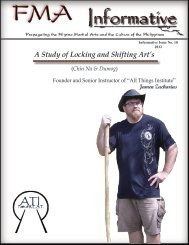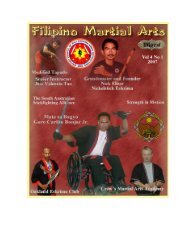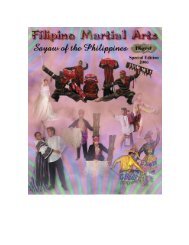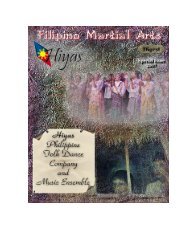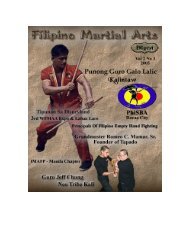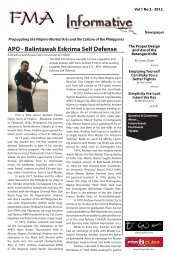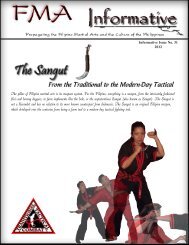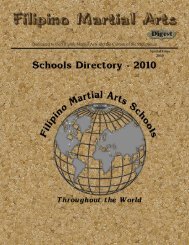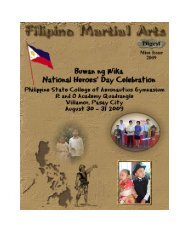Tournaments - FMA Informative
Tournaments - FMA Informative
Tournaments - FMA Informative
You also want an ePaper? Increase the reach of your titles
YUMPU automatically turns print PDFs into web optimized ePapers that Google loves.
as ways how to counter these attacks, such as: evasion, controlling, and disarming<br />
techniques.<br />
Dos Manos - means two hands or two fists and is a term used to refer to the manipulation<br />
of various kinds of weapons. In this area of training, the use of a heavier and long<br />
weapon is taught. Weapons such as "kampilan" (a long heavy sword), "bangkaw / sibat"<br />
(spear / staff) are taught. Skills developed in this training is easily transferable to emptyhand<br />
fighting.<br />
Panuntukan - literally translate to "fist fighting". In this area of training the use of<br />
various natural weapons of the human body is taught, such as: finger jabs to the eye, fist<br />
strike, palm strike, hammer fist, forearm smashes, elbow strikes, head butts, shoulder and<br />
hip smashes. Panuntukan is referred to as "dirty boxing".<br />
Sikaran or Panadyakan - is the opposite of panuntukan, literally translated as "foot<br />
fighting". In this area of training, the use of various parts of the legs as a weapon is<br />
taught. Kicks in this art are employed in various ways and manner, and is usually directed<br />
to the low line area. The emphasis in this art is the incapacitation of the opponent's legs.<br />
At close quarter, the knees are employed effectively. The combination of "panuntukan"<br />
and "sikaran" gives you a very effective empty hand self-defense system.<br />
Tanikalang Kamay / Kadena De Mano - Tanikalang Kamay or Kadena De Mano<br />
literally translated means "chain of hands". This term describes the constant and rapid<br />
motions of both hands. This art is the empty hand translation of all weapons techniques in<br />
close quarters. Every natural weapon in the human anatomy are employed in this range of<br />
fighting. The trapping and destruction of the opponent's<br />
limbs is the priority in this art. This is commonly called<br />
"defanging the snake". This is the art to use before<br />
going into the grappling range.<br />
Dumog / Layug - are Visayan words that means<br />
grappling / wrestling. In this area of training various<br />
pressure points and leverage are taught to manipulate<br />
opponents much larger than you. Practitioners of dumog<br />
are able to choke, strangle, throw, sweep, and secure<br />
various locks with or without the use of a weapon.<br />
Common everyday items such as: clothing,<br />
handkerchief, belt, etc. are used to aid in the execution<br />
of techniques.<br />
International Rutano Estokada Federation<br />
The International Rutano Estokada Federation was formed for the purpose of<br />
promoting and preserving the "Warrior Arts" of the Philippines. According to historians,<br />
when the ten Bornean Datus came to the Central Philippine island of Panay, they<br />
established a "Bothoan" or a tribal school that teaches basic reading, writing, home<br />
economics for women, as well as their fighting arts. Training in these fighting arts<br />
includes the used of various weapons such as: swords, stick, daggers, blowgun, bow and<br />
arrow, darts, "buntot pagi" (tail of a stingray), spear, and the use of various farm<br />
implements. The empty hand system includes punching (panuntukan), kicking (sikaran),<br />
wrestling/grappling (dumog/layug), locking, choking, and bone breaking techniques.<br />
During this period the "warrior arts" of our forefathers was known as "kali",



